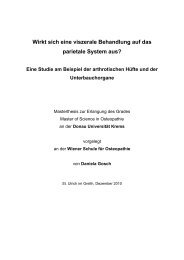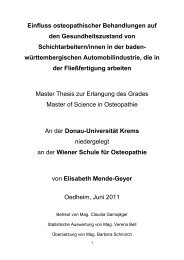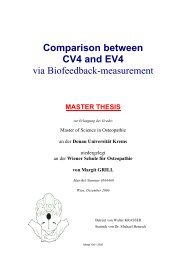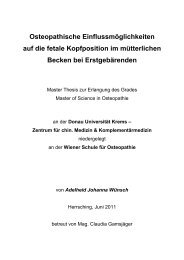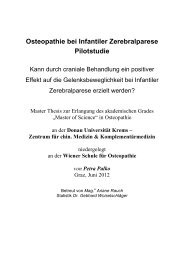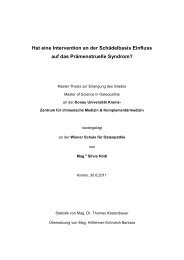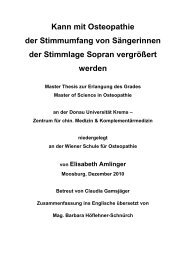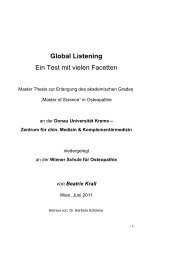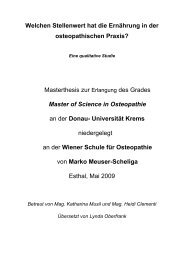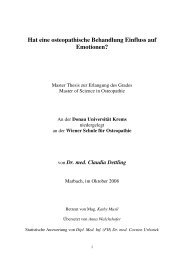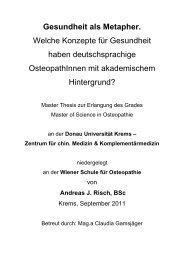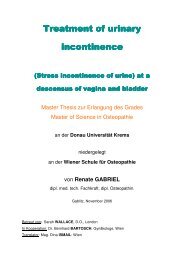2 Der viszeral assoziierte Schulterschmerz - Osteopathic Research
2 Der viszeral assoziierte Schulterschmerz - Osteopathic Research
2 Der viszeral assoziierte Schulterschmerz - Osteopathic Research
Sie wollen auch ein ePaper? Erhöhen Sie die Reichweite Ihrer Titel.
YUMPU macht aus Druck-PDFs automatisch weboptimierte ePaper, die Google liebt.
Viscerally Associated Shoulder Pain<br />
Subjective Perspectives and Diagnostic Procedures – the <strong>Osteopathic</strong> Point of View<br />
In the framework of the osteopathic evaluation process to identify visceral symptoms,<br />
it could be demonstrated that the case history was an important element for all seven<br />
interview partners and that all interview partners ask questions related to possible<br />
organic diseases. The high importance attributed to the case history is consistent<br />
with the results of the master thesis of Stemeseder (2007). Only three interview<br />
partners also explicitly explore the mechanism of onset and conduct a pain analysis.<br />
This last aspect does not follow the recommendations in the osteopathic<br />
(Hinkelthein/Zalpour 2006; Croibier 2006; Mayer-Fally 2007; Hebgen 2008) and<br />
medical literature (cf. Diemer/Sutor 2010).<br />
Four interview partners include observation in their diagnostic process. This result is<br />
consistent with the results of the study done by Krönke (2006) but not with the study<br />
of Biberschick (2010) in which 100% of all interview partners include observation. It<br />
has to be stressed that only one interview partner draws detailed conclusions on a<br />
possible organ dysfunction as indicated by postural changes. This aspect is not<br />
consistent with the observations and comments in the osteopathic literature that<br />
clearly indicates that when observing his/her patient the therapist pays attention to<br />
diagnostic zones and dysfunctional organs (cf. Croibier 2006; Mayer-Fally 2007;<br />
Hinkelthein/Zalpour 2006; Hebgen 2008; Fossum 2010).<br />
The global osteopathic examination showed that the listening is of particular<br />
relevance in the osteopathic diagnostic process. Six interview partners consider this<br />
myofascial test as particularly important when recognizing visceral problems in<br />
relation with shoulder joint dysfunctions. This high importance is consistent with the<br />
findings in the study done by Krönke (2006) and Biberschick (2010).<br />
Concerning the myofascial tests, four interview partners use inhibition, two use the<br />
Sotto-Hall test during their osteopathic diagnostic process. The frequency of use of<br />
the Sotto-Hall test is also reflected in the study done by Stemeseder (2007). When<br />
asked why they did not use this test, four interview partners explicitly mentioned the<br />
questionable reliability and validity of this test. This aspect is even more interesting if<br />
one considers the fact that the interview partners did not demonstrate the same<br />
reservation regarding the reliability and the validity of the global listening. With<br />
reference to this last point, it has to be stated that a study on the intra-rater and interrater<br />
reliability (Rittler 2010) of the initial position in standing only revealed a chance<br />
agreement and that the qualitative criterion for the reliability of the listening test on<br />
the abdomen was not met (Podlesnic 2006).<br />
142 | S e i t e



